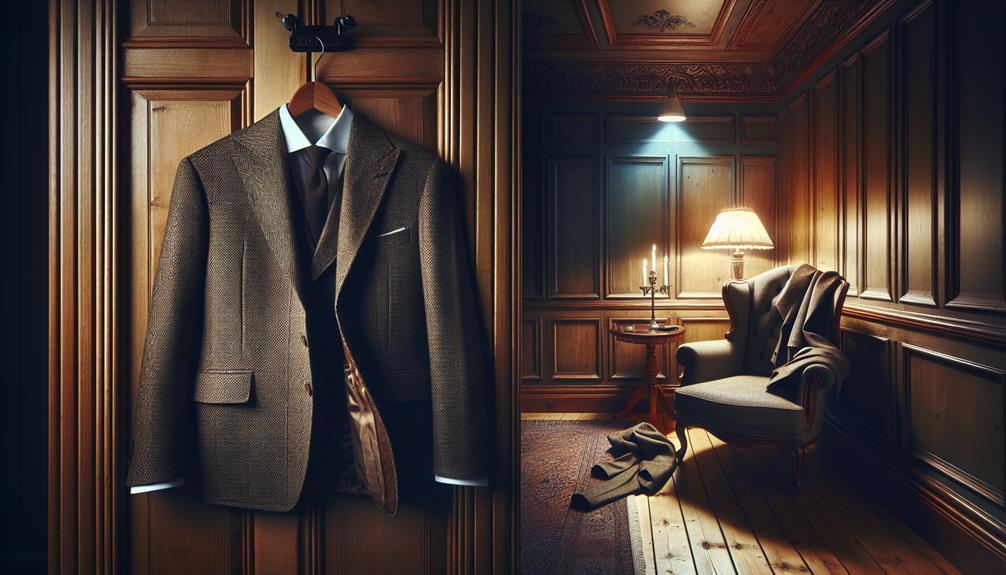I've always appreciated tweed for its classic look and durability, especially when it comes to staying wrinkle-free. It's woven in a way that makes it resistant to creasing, thanks to those tight, interlocking fibers. However, I'm curious about how different blends and treatments might affect this resilience. For instance, does a wool-silk tweed blend hold up as well as pure wool? And what about the impact of how we care for our tweed garments? Let's unpack these nuances together and see if we can figure out the best ways to keep our tweed looking sharp.
Table of Contents
Key Takeaways
- Tweed's tight weave and dense structure enhance its resistance to wrinkles.
- Pure wool tweed naturally has better elasticity, aiding in wrinkle recovery.
- Blends with synthetic fibers may decrease tweed's wrinkle resistance compared to pure wool.
- Regular maintenance like brushing and proper storage helps maintain tweed's wrinkle-free appearance.
- Ironing with moisture control and appropriate heat settings can effectively manage any creases in tweed.
The Composition of Tweed
Tweed is primarily made from wool, but it can also include blends of cotton, silk, or synthetic fibers. This mix not only influences the texture and feel but also the durability and appearance of the fabric. Let's explore how these materials come together in the tweed production process.
At its core, tweed production starts with the raw fibers being spun into yarn. The type of wool used often comes from specific breeds of sheep, each contributing unique qualities to the yarn. For instance, wool from Cheviot or Shetland sheep is commonly used, known for their robust and somewhat coarse fibers that are ideal for the hard-wearing nature of tweed.
Next up in the production line are the fabric weaves. Tweed is famous for its variety of weaves which can range from plain to twill, or more complex patterns like herringbone and check. These weaves aren't just about aesthetics; they also add to the fabric's strength and flexibility. The choice of weave affects the drape and wearability of the tweed, making it suitable for everything from casual wear to more formal attire. Understanding these elements is key to mastering the art of selecting and utilizing tweed effectively.
Characteristics of Tweed Fabric
Let's talk about what makes tweed stand out.
First off, tweed has rich origins that contribute to its unique style and texture.
Then, we'll look at how durable it is and share some easy tips for keeping your tweed looking great.
Tweed Fabric Origins
Many people don't know that the origins of tweed fabric trace back to Scotland, where it was first crafted for its durability and resistance to harsh weather. Delving into tweed history, it's clear that this fabric wasn't just about function. Tweed patterns, which have become iconic, were originally a form of identity for different Scottish clans and regions. These patterns were not just random but were carefully designed to blend with the natural landscapes.
Here's a quick look at some key aspects of tweed fabric:
| Aspect | Detail | Impact |
|---|---|---|
| Origin | Scotland | Suited to cold, damp climates |
| Patterns | Distinct, varied | Clan and regional identity |
| Material | Mainly wool | Warmth and durability |
| Weaving | Twilled, some plain | Unique texture and depth |
Understanding these origins and characteristics helps appreciate tweed's timeless appeal and versatility.
Durability of Tweed
Now let's consider how the tough, woven structure of tweed contributes to its remarkable durability. The dense, interlocked fibers not only resist pulling apart but also cope well with wear and tear. This toughness makes tweed an excellent choice for outerwear that faces the elements.
Another key feature enhancing tweed's durability is its natural flexibility. Unlike more rigid materials, tweed can bend and move with you, reducing the stress on the fabric and preventing tears.
Tweed's insulation properties also play a role here. By trapping air within its fibers, tweed maintains its structure and prevents breakdown from temperature fluctuations. All these characteristics combined make tweed a long-lasting fabric choice, well-suited for those who demand both style and substance.
Tweed Maintenance Tips
Caring for tweed isn't tricky, but it does require some specific steps to keep it looking its best.
First off, to combat color fading, it's important to store tweed away from direct sunlight. I often rotate my tweed garments in the closet to make sure they don't get constant exposure, which helps maintain their vibrant colors.
For seasonal storage, it's essential to keep tweed in a cool, dry place. I use breathable garment bags to avoid any mustiness or fabric deterioration.
Regular brushing after each wear also removes surface soil and prevents the fibers from becoming matted.
Wrinkle Resistance in Tweed
So, let's talk about what tweed's made of and how you should take care of it.
Knowing its composition helps explain why it's generally good at resisting wrinkles.
And I'll give you some easy tips on keeping your tweed looking sharp without too much fuss.
Tweed Fabric Composition
Tweed's unique blend of wool and tight weave greatly enhances its resistance to wrinkles. This fabric's composition plays an important role in its durability and aesthetic appeal. You'll find that tweed types vary widely, each bringing its own set of characteristics. For example, Harris Tweed is known for its robust texture, while Donegal tweed boasts colorful specks woven into the fabric.
Understanding tweed's weave and wool type helps in appreciating its resilience and style versatility. The color variations in tweed are not just about aesthetics; they also indicate the type of tweed and its origin. Here's a quick look at how these elements come together:
| Aspect | Detail |
|---|---|
| Weave | Tight, complex |
| Wool Type | Primarily sheep wool |
| Tweed Type | Harris, Donegal, etc. |
| Color | Earthy to vibrant |
| Texture | Rugged to refined |
Caring for Tweed
To maintain your tweed looking sharp and minimize wrinkles, it's crucial to follow a few simple care guidelines.
First, always hang tweed garments on wide, padded hangers to preserve their shape and prevent creasing.
Avoid over-washing to safeguard the fabric's natural resilience and color retention. When cleaning is necessary, opt for dry cleaning to uphold the integrity and prevent tweed softening beyond the desired texture.
If you're caught in a pinch and need to remove minor wrinkles, gently steam them out rather than ironing. This method helps sustain the fabric's robust texture without flattening it unnecessarily.
Factors Affecting Tweed Wrinkles
Several factors influence whether tweed wrinkles, including the fabric blend and weave tightness. Tweed's unique structure, often a mix of different fibers, plays a huge role here. Pure wool tweed tends to have better elasticity, bouncing back from creases more easily than blends with synthetic fibers. This elasticity helps in maintaining the fabric's smooth appearance even after sitting for hours or being packed in a suitcase.
The tightness of the weave also affects wrinkle resistance. Tightly woven tweed holds its shape and resists creasing more effectively than loosely woven variants. It's all about how the fibers lock together; the tighter they are, the less room there's for the fabric to bend and form wrinkles.
Moreover, the natural resilience of tweed to wrinkles is complemented by its ability to retain color, which indirectly impacts its appearance over time. Fabrics that fade or discolor easily can highlight wrinkles more prominently. Thankfully, tweed's dense weave protects its dyes, ensuring that colors stay vibrant and mask minor creases.
Understanding these factors can help you choose the right tweed garments that will look sharp with minimal care, focusing on blends and weaves that suit your lifestyle.
Caring for Tweed Garments
Now that we've looked at what impacts tweed's tendency to wrinkle, let's talk about how to take care of it.
I'll cover the best ways to clean tweed and the dos and don'ts of storing it.
Keeping your tweed in top shape isn't just about cleaning it right; how you store it matters a lot too.
Proper Tweed Cleaning
Caring for tweed garments isn't as intimidating as it seems; regular cleaning can keep them looking their best. It's important to understand that not all tweeds are the same, so checking the care label before proceeding is vital. For most, dry cleaning is a safe bet. It helps avoid shrinking and maintains the fabric's integrity. However, always make sure your dry cleaner knows how to handle tweed.
For small stains, spot treatment options are your friend. Gently dabbing with a mild soap and water solution can do the trick without the need for a full clean. Just be careful not to rub too hard, as this can damage the fibers. Regular, careful maintenance can greatly extend the life and appearance of your tweed items.
Storing Tweed Correctly
After discussing how to clean tweed, let's talk about the best ways to store it to maintain its quality. First things first, climate control is essential. You'll want to keep your tweed in a cool, dry place to prevent moisture from weakening the fibers. Avoid areas with high humidity or fluctuating temperatures, which can cause the material to expand and contract, leading to potential damage.
Now, onto hanging methods. Always use padded or wooden hangers for your tweed garments. These provide adequate support without distorting the shoulders or causing creases. Never fold tweed, as it can lead to permanent wrinkles. By following these tips, you'll make sure that your tweed stays pristine and ready for any occasion.
Storing Tweed Properly
To keep your tweed looking great, store it in a cool, dry place away from direct sunlight. Climate considerations are essential when dealing with tweed. Humidity is the enemy here, folks. If it's too damp, your tweed can get musty; too dry, and it might become brittle. I've found that maintaining a consistent environment prevents most potential damage.
Now, let's talk about hanging methods. Don't just throw your tweed in the closet on any old hanger. I use broad, padded hangers to maintain the shape of the jacket or coat without stretching the shoulders. For trousers, clamping hangers that grip the waistband work best. They hang smoothly without creating creases.
I also make sure there's enough space in my closet. Tweed needs to breathe, and cramming it in tightly with other garments can cause it to wrinkle or even mold. So, I always leave a bit of room around each piece.
Lastly, I never store tweed in plastic garment bags. They trap moisture and can lead to mildew. Instead, I opt for breathable fabric covers that protect the tweed while allowing air circulation. This simple step keeps my tweed in pristine condition, ready for any occasion.
Ironing and Pressing Tweed
Now that we've covered how to store your tweed to prevent wrinkles, let's talk about how to smooth them out if they do appear. Ironing tweed can be a bit tricky, but with the right technique, you can do it without causing damage.
First off, it's important to check your iron's heat settings. Tweed is generally made from wool, so setting your iron to the wool setting is a safe bet. This will usually be a medium to low heat, preventing any scorching. If you're unsure, it's better to err on the side of caution and go lower.
Next, let's talk about moisture control. Never iron tweed dry. The fabric responds well to a bit of moisture which helps in easing out wrinkles without much effort. You can use a steam iron or a damp pressing cloth. If using a cloth, lay it over the tweed and gently press the iron on top. Don't drag the iron back and forth; instead, lift and press in sections.
Professional Cleaning Tips
While ironing at home can do the trick, sometimes taking your tweed to a professional cleaner is the best way to guarantee it stays in pristine condition. I've learned that tweed, with its dense weave, responds well to professional care, especially when it comes to maintaining its shape and texture.
Professional cleaners use dry cleaning solvents that are specifically designed to be gentle on tweed's natural fibers, ensuring there's no shrinkage or color fading. Unlike water, these solvents don't penetrate the fibers deeply, which means your tweed retains its form and strength. And when you're dealing with stains, the techniques used by these experts make a world of difference. I've seen how they tackle spots without spreading them or harming the fabric.
Here's a quick table of common issues with tweed and how professional cleaning can address them:
| Issue | Professional Solution | Benefit |
|---|---|---|
| Wrinkles | Specialized pressing | Keeps structure and avoids damage |
| Stains | Targeted stain removal | Effective without harming fibers |
| Odors | Use of dry cleaning solvents | Refreshes fabric without washing |
Common Misconceptions About Tweed
Many people mistakenly believe that tweed is only suitable for cold weather, but it's actually quite versatile. This misconception might stem from tweed's historical association with autumn and winter hunting attire in the British Isles. However, the reality is that tweed can be worn in various climates depending on the weave and weight. It's not just about staying warm; it's about style and functionality too.
Another common misunderstanding is that tweed is outdated or not fashionable. On the contrary, tweed's popularity has seen a significant resurgence. Modern tweed styles blend traditional craftsmanship with contemporary cuts and colors, making it a staple for both high fashion and street style. It's no longer just the fabric of choice for academics and the countryside elite; tweed has been embraced by designers who are crafting everything from classic coats to trendy accessories.
Lastly, some think tweed is all the same. In reality, there's a vast array of tweed styles, each with unique characteristics. From Harris to Donegal, the patterns, textures, and colors vary widely, offering something for every taste. Understanding these options can truly enhance your wardrobe and personal style.
Extending the Life of Tweed
To extend the life of your tweed garments, proper care and maintenance are vital. I've learned that the way you handle tweed tailoring can make a huge difference. First, always check the care label. Some tweed can be washed at home, but dry cleaning is often the safest bet to preserve the fabric's integrity and appearance. Avoid frequent washing; tweed doesn't need it and it'll last longer that way.
When it comes to storing tweed, especially if you're thinking about seasonal usage, keep your garments in a cool, dry place. Use padded hangers to maintain the shape of the jackets and avoid folding them to prevent creasing. Moth-proofing is essential too, because tweed is woolen and can attract moths. Cedar blocks or lavender sachets in your wardrobe can help protect your items.
Lastly, if you're wearing tweed regularly, rotate your garments to avoid excessive wear and tear on any one piece. And, if you notice a small tear or unraveling seam, get it to a professional for repair sooner rather than later. Taking these steps ensures that your tweed stays in prime condition for years to come.
Frequently Asked Questions
Can Tweed Be Dyed to a Different Color After Purchase?
Yes, I've successfully dyed tweed to a different color after buying it. Using proper dyeing techniques guarantees good color retention, but it's essential to select dyes suitable for tweed's unique fabric composition.
Is Tweed Suitable for Summer Wear?
I wouldn't recommend tweed for summer wear due to its heat retention. It's not the most breathable fabric, making it less comfortable in hot weather compared to lighter, more breathable materials.
How Does Tweed Impact the Environment?
Tweed's environmental impact hinges on its production methods. Sustainable production minimizes harm, but chemical treatments used for durability can be problematic. I'm exploring greener options to reduce these effects while maintaining quality.
Are There Vegan Alternatives to Tweed?
Yes, there are vegan alternatives to tweed! I've explored synthetic options that offer similar texture. These fabrics prioritize sustainability without compromising style—perfect for those seeking eco-friendly, animal-free wardrobe choices.
What Are the Historical Origins of Tweed Fabric?
Tweed originated in Scotland in the 18th century, primarily for durability in harsh weather. Tweed production evolved, integrating various Tweed styles, reflecting local traditions and the specific needs of different communities.
- How Does Ring Spun Cotton Affect Garment Fit and Shape Retention? - August 13, 2024
- What Are the Challenges in Producing Ring Spun Cotton? - August 13, 2024
- Is Ring Spun Cotton Suitable for Plus-Size Clothing? - August 13, 2024







